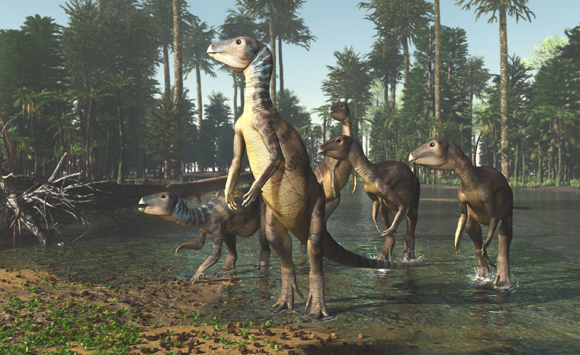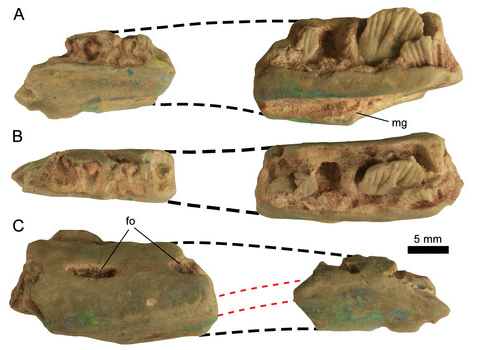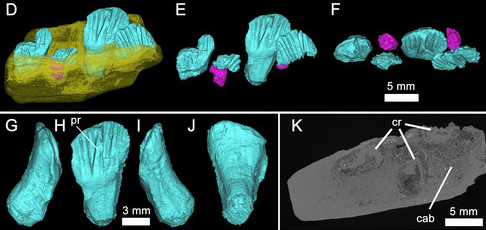New Dinosaur Named from New South Wales
Weewarrasaurus pobeni – Hints at Different Kinds of Dinosaur Communities
The fortuitous discovery of pieces from the lower jaw of a small, plant-eating dinosaur is helping scientists to discover more about the Cretaceous dinosaurs that once roamed Australia. Writing in the academic journal “PeerJ”, the researchers provide evidence to support the idea that there were numerous small-bodied ornithopods at high latitudes in south-eastern Australia, whilst further north, in what would have been slightly warmer environments, these types of dinosaurs co-existed with much bigger ornithopods and titanosaurs.
The dinosaur has been named Weewarrasaurus pobeni (pronounced wee-whah-rar-sore-us poe-ben-eye) and it is the first new dinosaur to be described from New South Wales for nearly 100 years.
A Life Reconstruction of the Newly Described Gondwanan Ornithopod Weewarrasaurus pobeni
Picture credit: James Kuether
A Lucky Fossil Find
Adelaide-based opal buyer Mike Poben spotted the fossil pieces in a bucket of opal rubble from the Wee Warra opal field at Lightning Ridge (New South Wales, Australia). The dinosaur was named in honour of the location and the trivial name recognises the contribution of Mr Poben who donated the specimens for research.
Numerous opalised dinosaur fossils are known from the Lightning Ridge area. The material, including fragments of bones and isolated teeth come from the Griman Creek Formation. Recent radiometric dating indicates that these deposits are around 100 to 96 million years old (Cenomanian stage of the Late Cretaceous), making these rocks some 10 million years younger than equivalent exposures containing dinosaur fossils found in northern Queensland.
The Fossil Jaw Fragments (Right Dentary) of Weewarrasaurus pobeni
Picture credit: PeerJ
Unfortunately, the underground mining process involves breaking up the rocks, so any specimens found tend to consist of isolated broken pieces, however the presence of a scalloped-shaped tooth in the object immediately caught the attention of Mr Poben, so he was able to quickly appreciate that this was part of a jawbone. Lightning Ridge is the only place in the world where dinosaur bones and teeth routinely turn to opal. Corresponding author of the scientific paper, Dr Philip Bell (University of New England), explained that researchers were now looking into acquiring more fossil material from opal mines.
Dr Bell stated:
“Unfortunately, the fossil remnants we see are almost always part of mining spoil… but on another hand, we would never get to see even those fragments if it wasn’t for mining.”
Opal Helps to Identify a Dinosaur
One of the benefits of the presence of opal in the fossil is that the distinctive banding pattern formed helped the scientists to identify that the two fossil pieces belonged to the same jawbone.
Views of the Jawbone Fossil (Weewarrasaurus pobeni)
Picture credit: PeerJ/Dr Bell (University of New England)
The picture above shows three views of the fossils, (A), medial; (B), dorsal; and (C) lateral views. The dashed black line shows the outline of the missing pieces that would have comprised a more substantial part of the dentary. The dashed red lines indicate the distinctive banding pattern in the opal used to estimate the extent of the missing area. Another jawbone fragment (LRF 766), representing a right dentary with teeth in situ from the nearby Three Mile opal field has also been assigned to this new dinosaur species.
Faunal Differences in Different Regions of Prehistoric Australia
The Griman Creek Formation fossils from Lightning Ridge indicate that there were numerous small Ornithopods living in this environment during the Cenomanian stage of the Late Cretaceous. This research provides further evidence to support previous studies that favour a general abundance of small-bodied basal Ornithopods in high-latitude localities of south-eastern Australia. These little dinosaurs, most of which were under two metres in length, inhabited a verdant flood plain, but this part of the Gondwana was at approximately 60 degrees south. Today, Australia is much further north, the city of Sydney (New South Wales), is located at approximately 33.86 degrees south. During the Cretaceous, the dinosaurs that inhabited the part of Australia we now call New South Wales, would have had to endure periods of darkness in the year when the sun dipped below the horizon, although the presence of ectothermic reptiles such as crocodyliforms and turtles indicate that average minimum temperatures may not have fallen below 5 degrees Celsius.
Even so, the climate may have been too extreme for sauropods. Cretaceous deposits in Queensland (Winton Formation), have revealed several titanosaurs, but the colder temperatures experienced further south may have limited sauropod distribution.
The researchers conclude that although future dinosaur fossil discoveries have the potential to alter these interpretations, it is suggested that the Griman Creek Formation at Lightning Ridge occupied a “meeting point” between more northern sauropod-dominated faunas and the ornithopod-dominated faunas that existed further south.
Computer Generated Images from Fossil Scans Helped to Identify Ornithopod Characteristics
Picture credit: PeerJ
To read a recent article about an opalised dinosaur toe bone found in South Australia: Lost Dinosaur Toe Bone Turns Up on the Internet.
Visit the award-winning Everything Dinosaur website: Everything Dinosaur.





